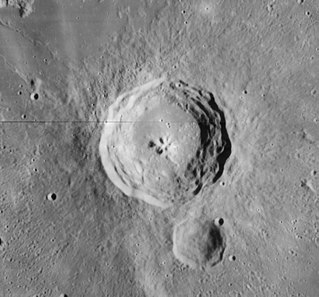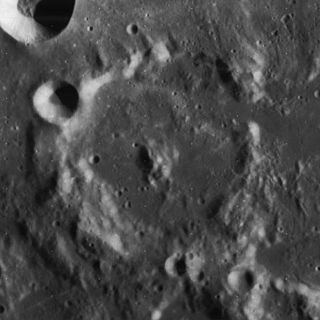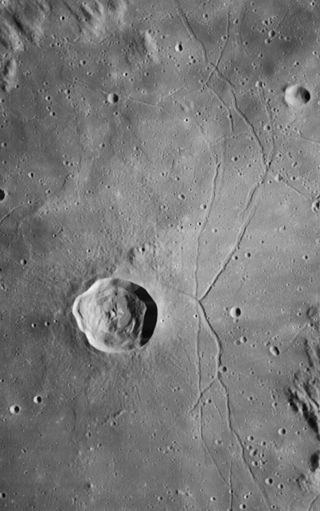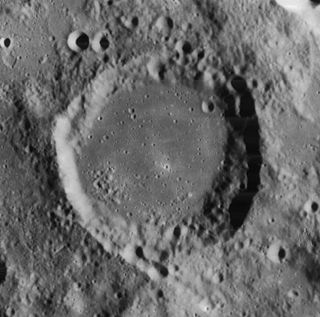
Mare Nubium is a lunar mare in the Nubium basin on the Moon's near side. The mare is located just to the southeast of Oceanus Procellarum.

Alphonsus is an ancient impact crater on the Moon that dates from the pre-Nectarian era. It is located on the lunar highlands on the eastern end of Mare Nubium, west of the Imbrian Highlands, and slightly overlaps the crater Ptolemaeus to the north. To the southwest is the smaller Alpetragius. The crater name was approved by the IAU in 1935.
Copernicus is a lunar impact crater located in eastern Oceanus Procellarum. It was named after the astronomer Nicolaus Copernicus. It typifies craters that formed during the Copernican period in that it has a prominent ray system. It may have been created by debris from the breakup of the parent body of asteroid 495 Eulalia 800 million years ago.

Fra Mauro is the worn remnant of a walled lunar plain. It is part of the surrounding Fra Mauro formation, being located to the northeast of Mare Cognitum and southeast of Mare Insularum. Attached to the southern rim are the co-joined craters Bonpland and Parry, which intrude into the formation forming inward-bulging walls. The crater is named after Italian geographer Fra Mauro.

Eratosthenes crater is a relatively deep lunar impact crater that lies on the boundary between the Mare Imbrium and Sinus Aestuum mare regions. It forms the western terminus of the Montes Apenninus mountain range. It is named after ancient Greek astronomer Eratosthenes of Cyrene, who estimated the circumference of the Earth, and the distance from the Earth to the Sun.

Bullialdus is a lunar impact crater located in the western part of the Mare Nubium. It was named after French astronomer Ismaël Boulliau. To the north by north-west is the broken-rimmed and lava-flooded crater Lubiniezky. South-west of Bullialdus lies the smaller crater König.

Thebit is a lunar impact crater located on the southeast shore of Mare Nubium. To the north-northwest is the crater Arzachel, and Purbach lies to the south-southwest. To the southwest is the flooded remnants of Thebit P, which is actually larger in diameter than Thebit itself.

Birt is a lunar impact crater located in the eastern half of the Mare Nubium and west of the Rupes Recta. It was named after British selenographer William R. Birt.

Hyginus is a lunar caldera located at the east end of the Sinus Medii. It was named after ancient Roman astronomer Gaius Julius Hyginus. Its rim is split by a 220 kilometer-long rille, Rima Hyginus, that branches to the northwest and to the east-southeast. The crater is deeper than the rille, and lies at intersection of the rille's branches. Together, the crater and the rille form a prominent feature in an otherwise flat surface. Smaller craters along the length of the rille may have been caused by the collapse of an underlying structure.

Hipparchus is the degraded remnant of a lunar impact crater. It was named after the Greek astronomer, geographer and mathematician Hipparchus. It is located to the southeast of Sinus Medii, near the center of the visible Moon. To the south is the prominent crater Albategnius, and to the southwest lies Ptolemaeus, a feature of comparable dimensions to Hipparchus. Horrocks lies entirely within the northeast rim of the crater. Halley is attached to the south rim, and Hind lies to the southeast. To the north-northeast is the bowl-shaped Pickering, and the flooded Saunder is located off the northeast rim. High-resolution images of Hipparchus were obtained by Lunar Orbiter 5 in 1967.

Burnham is a small crater located to the southeast of the crater Albategnius, in a relatively smooth area of the lunar surface. It was named after American astronomer Sherburne W. Burnham. To the southwest is Vogel.

Cauchy is a small lunar impact crater on the eastern Mare Tranquillitatis. It was named after French mathematician Augustin-Louis Cauchy. It is circular and symmetric, with a small interior floor at the midpoint of the sloping inner walls. Due to the high albedo of this bowl-shaped formation, it is particularly prominent at full Moon.

Pallas is a heavily eroded lunar impact crater located to the north of the Sinus Medii. It was named after the German-born Russian natural historian Peter Simon Pallas. To the northwest is the smaller but less worn crater Bode. Pallas shares a low wall with the crater Murchison that is attached to the southeast, and there are two gaps in the shared rim.

Gassendi is a large lunar impact crater feature located at the northern edge of Mare Humorum. It was named after French astronomer Pierre Gassendi. The formation has been inundated by lava during the formation of the mare, so only the rim and the multiple central peaks remain above the surface. The outer rim is worn and eroded, although it retains a generally circular form. A smaller crater – Gassendi A – intrudes into the northern rim, and joins a rough uplift at the northwest part of the floor. The crater pair bear a curious resemblance to a diamond ring.

Triesnecker is a prominent lunar impact crater that is located in the Sinus Medii, near the central part of the Moon's near side. Its diameter is 25 km. It was named after Austrian astronomer Franz de Paula Triesnecker. It is located to the north-northwest of the crater Rhaeticus, and to the east-southeast of the flooded Murchison.

Abulfeda is a lunar impact crater located in the central highlands of the Moon. To the northeast is the crater Descartes, and to the south-southeast is Almanon. To the north is the crater Dollond. A chain of craters named the Catena Abulfeda runs between the southern rim of Abulfeda and the north rim of Almanon, then continues for a length of 210 kilometers across the Rupes Altai. The crater was named for 14th century Kurdish historian Ismael Abul-fida.

Arago is a lunar impact crater located in the western part of the Mare Tranquillitatis. It was named after French astronomer François Arago in 1935. Its diameter is 26 km. To the southwest lies the crater Manners, and beyond are Dionysius and the Ritter–Sabine crater pair. To the southeast is the large Lamont formation that has been submerged by the mare.

Gambart is a small lunar impact crater on the Mare Insularum, near the central region of the Moon. It is named after French astronomer Jean-Félix Adolphe Gambart. It can be located to the south-southeast of the prominent ray crater Copernicus. In the past, the floor of Gambart has been flooded with lava, leaving a relatively flat surface surrounded by a smooth but somewhat polygon-shaped outer rim. To the southwest of Gambart is an area of hilly terrain deposited from ejecta during the Mare Imbrium impact, known as the Fra Mauro Formation.

Rupes Altai is an escarpment in the lunar surface that is located in the southeastern quadrant of the Moon's near side. It is named for the Altai Mountains in Asia, and is the most prominent lunar escarpment. The selenographic coordinates of this feature are 24.3°S 22.6°E, and it has a length of about 427 km.

Rupes Boris is a short fault or ridge in the lunar surface that is located in the northwestern quadrant of the Moon's near side, within Mare Imbrium. Its name was adopted in 1985 by the International Astronomical Union, and was taken from the tiny nearby crater Boris. The selenographic coordinates of this feature are 30.5°N 33.5°W, and it has a length of just 4 km.






















